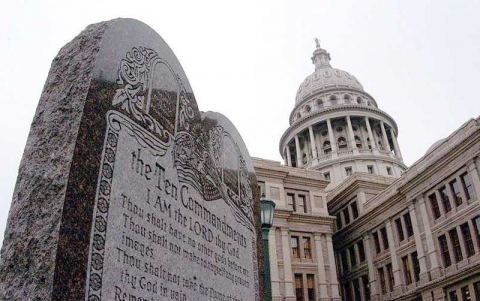Texas Voter ID Law: After a 147-Page Opinion and a 5 am Order, Texas May Use Its Voter ID Law in 2014

by: Matt Dearmond
The controversial Texas voter ID law, Senate Bill 14 (S.B. 14), is in effect for the 2014 election as a result of a Supreme Court order on October 18. The order came after a U.S. District Court issued a decision striking down the law because it infringed the right to vote, discriminated against minority voters, would operate like a poll tax, and violated the Voting Rights Act.
Texas Governor Rick Perry signed S.B. 14 into law in 2011. The law is considered to be one of the strictest voter ID laws in the country. It requires all voters to show one of a few specified forms of photographic identification when voting. Critics claim that Texas is discriminating against minorities, poor people, and students, all who tend to vote for Democratic candidates.
When Governor Perry signed the law, Section 5 of the Voting Rights Act required states with a history of discrimination – which included Texas – to receive federal approval, or “preclearance,” before implementing changes to their voting laws, proving that the new law would not discriminate against minority voters. On August 30, 2012, the D.C. District Court denied preclearance of S.B. 14 because Texas failed to show that the law lacked both a discriminatory purpose and effect.
While Texas’s appeal of the District Court’s opinion was pending in 2013, however, the Supreme Court issued its landmark decision in Shelby County, Alabama v. Holder, holding that the preclearance formula was unconstitutional because it applied 40-year-old facts to the present day. Without a preclearance formula, Section 5 was rendered inoperable, leaving previously covered states such as Texas free to institute changes to their election laws without federal pre-approval. Within an hour of the Shelby County decision, Texas announced that it would put S.B. 14 into full effect.
From there, the Obama administration and various civil rights groups brought suit against Texas, alleging that S.B. 14 was unconstitutional and unlawful.
District Court Order Ruling Texas Voter ID Law Unconstitutional and Unlawful
On October 9, 2014, Judge Ramos of the U.S. District Court for the Southern District of Texas struck down S.B. 14 in a 147-page opinion. The court held that the bill created an unconstitutional burden on the right to vote, imposed an impermissible discriminatory effect against Hispanics and African-Americans, and was enacted with an unconstitutional discriminatory purpose. Based on the testimony and opinions of multiple experts, Judge Ramos’s opinion laid out a timeline of the state’s history of discrimination, which she explained, “permeated all aspects of life in Texas,” resulting in Hispanics and African-Americans making up a disproportionate number of people living in poverty. Judge Ramos detailed evidence of Texas’s discriminatory history, citing redistricting decisions since 1970 that the state had lost and the previous denial of preclearance for this voter ID law based on its discriminatory effect. Simply put, Judge Ramous ruled that Texas could not use its voter ID law for this – or any – election because it would infringe the right to vote.
Fifth Circuit Court of Appeals Issues Stay
With the final order of the District Court coming down just nine days before early voting began in Texas, and twenty-four days before Election Day, the Fifth Circuit Court of Appeals issued a stay of the district court’s decision. The Fifth Circuit expressed concern about the impact the District Court’s judgment would have on the upcoming election.
The court’s concern for the preservation of the status quo immediately before an election derived from the Supreme Court’s decision in a case known as Purcell v. Gonzalez. Under the Purcell doctrine, courts should refrain from issuing an opinion too close to Election Day if it will cause voter confusion or otherwise upset the status quo. Multiple court orders can create voter confusion, especially close to an election. Moreover, granting immediate effective relief is particularly troublesome when a State’s election machinery is already in progress. The Fifth Circuit found that Texas had already begun training poll workers under the new system and would be unable to reprint and redistribute new election manuals throughout the state in response to the district court’s decision.
The U.S. Supreme Court Denies the Plaintiff’s Motion to Vacate and S.B. 14 Goes Into Effect
In a brief, one-paragraph order issued at 5:00 am on Saturday, October 18, 2014, the Supreme Court denied a motion to vacate the Fifth Circuit’s stay. As a result, S.B. 14 went into effect for this election. Justice Ginsburg, joined by Justices Kagan and Sotomayor, dissented from the order. She noted that this case was different from the others in which the Court had issued a stay under the Purcell doctrine because it involved a “permanent injunction following a full trial and resting on an extensive record from which the District Court found ballot access discrimination by the State.” She would not “upset the District Court’s reasoned, record-based judgment, which the Fifth Circuit accorded little, if any, deference.”
The upshot is Texas will use its stricter voter ID for this election, even though a federal court, after an extensive trial and lengthy opinion, found that the law might infringe the right to vote of thousands of voters. This temporary pause in the law, however, is only the latest development in a lengthy story of litigation over voter ID in Texas. After the 2014 election, the DOJ is likely to seek to “bail in” Texas to the Voting Rights Act preclearance regime based on the finding of intentional discrimination, while the Fifth Circuit, and perhaps the Supreme Court, will weigh in the merits of the law.
Voter ID is in force in Texas this year. But this is likely just a prelude to continuing battles over voter ID leading up to the 2016 presidential election.
